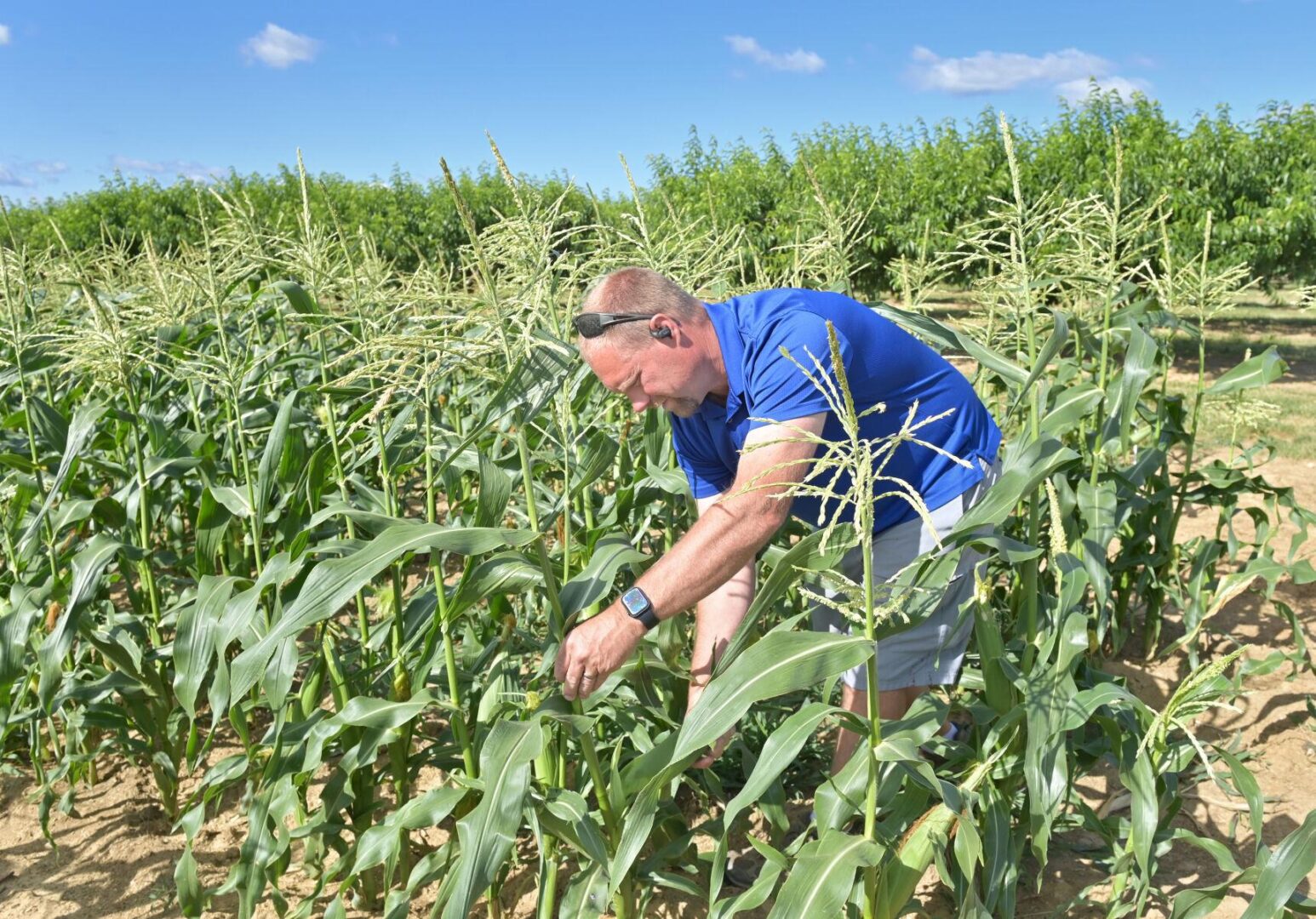
Corey McCleaf, one of the co-owners of Cherry Hill Orchards, pulls an ear of sweet corn that will be ready for consumption within 7-10 days on Monday, June 24, 2024.
Suzette Wenger / LNP | LancasterOnline

Corey McCleaf, one of the co-owners of Cherry Hill Orchards, pulls an ear of sweet corn that will be ready for consumption within 7-10 days on Monday, June 24, 2024.
Suzette Wenger / LNP | LancasterOnline

Suzette Wenger / LNP | LancasterOnline
Corey McCleaf, one of the co-owners of Cherry Hill Orchards, pulls an ear of sweet corn that will be ready for consumption within 7-10 days on Monday, June 24, 2024.
As spring rains give way to summer heat, Lancaster County farmers are managing moisture and fending off a rise of insect pests that has been particularly pronounced this year while consumers reap the benefits of sun-drenched produce.
As long as farmers have access to adequate water for irrigation, produce growers will benefit from the sun building up sugars in the developing crops and consumers can look forward to sweeter summer crops like cantaloupes and watermelons, Penn State Extension horticulture educator Tim Elkner said. He also predicted a good crop of sweet corn.
Venues like Cherry Hill Orchards in Pequea Township that rely on the entertainment value of pick-your-own produce are hoping for sunny weekends to attract crowds.
“We’re really looking for good Saturday weather,” owner Corey McCleaf said.
In addition to its market produce, Cherry Hill cycles through pick-your-own offerings – the cherry crop is nearing its end, with peaches and blackberries up next. A new crop of blueberries is on drip irrigation and will be ready to pick later in the summer, while the sweet corn crop should hit market shelves in about a week.
A dry year creates more work for farmers but yields higher quality produce, McCleaf said.
“We could use a little bit of rain,” McCleaf said, “but we are irrigating.”
The drying fields could prove a challenge for later plantings as produce farmers finish out their rotational schedules, Elkner said.
The arrival of dry heat will also put the county’s corn and soybeans under stress, but those hearty crops can weather some drought early in their development without losing too much yield potential, Penn State Extension agronomy educator Jeff Graybill said.
“Certainly, we would benefit from some rain in the near future and cooler temperatures,” Graybill said, “but we are far from a serious crop loss at this time.”
The row crops that dominate the county’s farming scene experienced a good spring planting season, Graybill said, as frequent but not excessive rain allowed most farms to plant in a timely manner.
“Last year we had a six-week period in May and June in the northern half of the county with the corn and soybeans looking pretty rough,” Graybill said, “but rain arrived in time and many folks had very good crops.”
One negative note has been slugs feeding on seedling corn and soybeans that has resulted in many farms having to replant fields or portions of fields where slugs consumed the crop.
“It seemed to be worse on soybeans than corn,” Graybill said, “I did see a photo someone took which had half a dozen slugs just devouring a small corn plant.”
Slugs like cool and wet weather, and the warm winter might have contributed to their presence in local fields, Graybill said. As warm and dry weather arrived, slug pressure has lessened.
“But many folks will have some fields which are uneven with replanted crops ready to be harvested a week or two later than the original crop in the same field, which is a nuisance,” Graybill added.
A lack of rain is a mixed blessing for produce farmers, Elkner said. Crops like tomatoes will avoid the rot that can accompany excess showers, but insects such as spider mites and thrips can thrive in hot, dry weather.
“Growers just need to go ahead and pay attention to what’s happening in the field,” Elkner said, “so that they make sure that these insects that can go ahead and build populations quickly don’t get ahead of them.”
Top crops in Lancaster County
The U.S. Department of Agriculture releases a Census of Agriculture every five years. The 2022 numbers reveal that row crops continue to dominate in Lancaster County. Here are the county’s top crops by acreage:
1. Corn for grain: 95,549
2. Forage, all: 65,142
3. Corn for silage: 35,988
4. Soybeans for beans: 51,695
5. Wheat for grain: 24,101
Agricultural products sold in Lancaster County totaled $1.85 billion in 2022. Here’s a breakdown of the county’s top crops by market value:
1. Grains, oilseeds, dry beans, peas: $180,574,000
2. Nursery, greenhouse, floriculture, sod: $67,393,000
3. Tobacco: $16,288,000
4. Vegetables, melons, potatoes, sweet potatoes: $28,732,000
5. Other crops and hay: $18,971,000
6. Fruits, tree nuts, berries: $13,230,000
7. Christmas trees, short rotation woody crops: $1,456,000
[\box]

Get insights into WITF’s newsroom and an invitation to join in the pursuit of trustworthy journalism.
The days of journalism’s one-way street of simply producing stories for the public have long been over. Now, it’s time to find better ways to interact with you and ensure we meet your high standards of what a credible media organization should be.